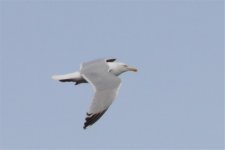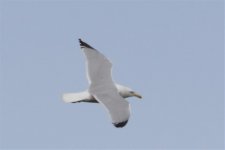
Hello all, this is my first proper post here since registering ages ago. I'd be very grateful for thoughts on the ID of this gull. The 2 photos were taken from the window of my London flat on 17 April (I used to be a fairly active if not very competent birder, but am now flatbound). From memory the light was cloudy bright.
I only saw the bird for 4 or 5 seconds before it disappeared behind trees, just time to focus manually with my Canon 100-400mm Mk1 & grab a couple of shots. I first took it to be a Herring Gull, but later the wingtip pattern with little white and apparently just a single mirror, on primary 1, and rather squared-off black wedges, brought to mind Yellow-legged Gull. The colour of the upperparts seemed a little dark for Herring, but it's difficult to assess plumage tones on a lone bird, nor are the photos good enough to get a clear idea of orbital ring colour or extent of red on the bill.
I now think it was probably Herring after all, but am still a bit puzzled by the wingtip pattern.
I shoot in RAW & jpeg, and did some basic processing in Digital Photo Professional 4; if it would help I could provide a jpeg taken from the RAW with no processing. Thanks in advance!
I only saw the bird for 4 or 5 seconds before it disappeared behind trees, just time to focus manually with my Canon 100-400mm Mk1 & grab a couple of shots. I first took it to be a Herring Gull, but later the wingtip pattern with little white and apparently just a single mirror, on primary 1, and rather squared-off black wedges, brought to mind Yellow-legged Gull. The colour of the upperparts seemed a little dark for Herring, but it's difficult to assess plumage tones on a lone bird, nor are the photos good enough to get a clear idea of orbital ring colour or extent of red on the bill.
I now think it was probably Herring after all, but am still a bit puzzled by the wingtip pattern.
I shoot in RAW & jpeg, and did some basic processing in Digital Photo Professional 4; if it would help I could provide a jpeg taken from the RAW with no processing. Thanks in advance!





